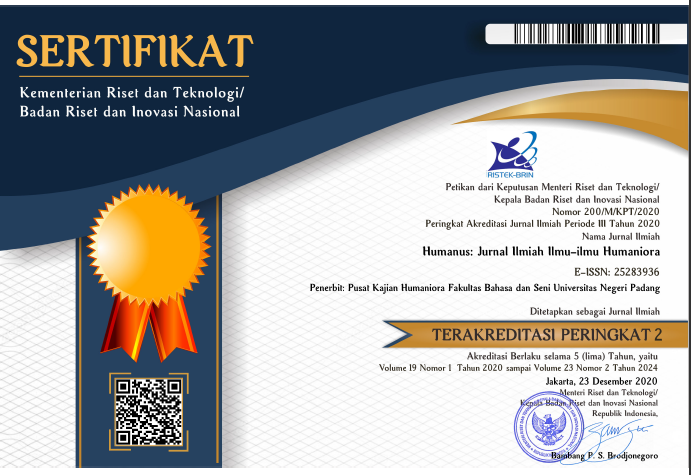CHAMPS CULTURE TO INCREASE EMPLOYEE PERFORMANCE
 ), Muhammad Ali Embi(2), Aziza Bila(3),
), Muhammad Ali Embi(2), Aziza Bila(3), (1) Universitas Negeri Padang
(2) Universiti Utara Malaysia
(3) Universitas Negeri Padang
 Corresponding Author
Corresponding Author
Copyright (c) 2019 Humanus
DOI : https://doi.org/10.24036/humanus.v18i1.104328
Full Text:
 Language : en
Language : en
Abstract
The objective of this study was to determine the influence of corporate culture in improving employees' performance at state-owned enterprise PT. Semen Padang, West Sumatra. This research used quantitative methods and was supported by qualitative data. Data were collected quantitatively from samples selected using Simple Random Sampling. Qualitative data was collected with observation and interview with purposive sampling technique. The population of PT. Semen Padang employees are 1924 people. The sample was calculated using Slovin's formula (error of 5%) and consisted of 331 samples. The initial hypothesis in this research consisted of seven hypotheses. This study found a significant influence of a corporate culture that consists of six variables of work culture in improving employees’ performance at PT. Semen Padang. This study also found other factors that affect employees' performance. This study offers managers at PT. Semen Padang the key to increasing their employees' performance. The essence of this study is to prove that there is a significant influence of corporate cultures in improving employees' performance.
Keywords
References
Alam Choudhury, M., & Ziaul Hoque, M. (2006). Corporate governance in Islamic perspective. Corporate Governance: The International Journal of Business in Society, 6(2), 116–128. https://doi.org/10.1108/14720700610655132
Bungin, B. (2013). Metodologi penelitian kuantitatif; komunikasi, ekonomi dan kebijakan publik serta ilmu-ilmu sosial lainnya. Jakarta: Kencana Prenada Media Group.
Chatman, J., & Bersade. (1997). Employee satisfaction, factor associated with company performance. 29–42.
Chen, L. Y. (2004). Examining the effect of organization culture and leadership behaviors on organizational commitment, job satisfaction and job performance at small and midle sized firm of Taiwan. Journal of American Academy of Business, 5(1), 432–439.
Dessler, G. (2005). Human resource management Gary Dessler (10th ed). Retrieved from https://trove.nla.gov.au/work/7896090
Flamholtz, E. G., & Randle, Y. (2012). Corporate culture, business models, competitive advantage, strategic assets and the bottom line: Theoretical and measurement issues. Journal of Human Resource Costing & Accounting, 16(2), 76–94. https://doi.org/10.1108/14013381211284227
Frinaldi, A. (2011). Analisis budaya kerja disiplin pegawai negeri sipil: studi pada beberapa pemerintah Daerah di Sumatera Barat. Jurnal Demokrasi, 10(2). Retrieved from http://ejournal.unp.ac.id/index.php/jd/article/view/1005
Frinaldi, A. (2014). Pengaruh budaya kerja pegawai negeri sipil terhadap pelayanan publik di dinas catatan sipil dan kependudukan Kota Payakumbuh. Humanus, 13(2), 180–192. https://doi.org/10.24036/jh.v13i2.4727
Frinaldi, A., & Embi, M. A. (2011). Pengaruh budaya kerja etnik terhadap budaya kerja keberanian dan kearifan pns dalam pelayanan publik yang prima (Studi Pada Pemerintah Kabupaten Pasaman Barat). 7.
Frinaldi, A., & Embi, M. A. (2015). Influence of public service quality in citizen satisfaction (study in private hospital Y in Padang, West Sumatra Province). Jurnal Studi Pemerintahan, 6(1), 88–101.
Frinaldi, A., Khaidir, A., & Rahayu. (2019). Policy management to develop tourism work culture consciousness and increasing visiting people’s satisfaction. Jurnal Studi Pemerintahan, 10(1), 49–67.
Golnaz, S. ; B. L. (2001). Developing corporate culture as a competitive advantage. Journal of Management Development, 20(1), 853–859.
Kotter, J. P., & Heskett, J. L. (2011). Corporate culture and performance (Reprint edition). Place of publication not identified: Free Press.
Ndraha, T. (2005). Budaya organisasi. Jakarta: Rineka Cipta.
Ntongho, R. A. (2016). Culture and corporate governance convergence. International Journal of Law and Management, 58(5), 523–544. https://doi.org/10.1108/IJLMA-04-2015-0016
Pasolong, H. (2010). Teori Administrasi Publik. Bandung: Alfabeta.
Srivastava, V., Das, N., & Pattanayak, J. K. (2018). Corporate governance: Mapping the change. International Journal of Law and Management, 60(1), 19–33. https://doi.org/10.1108/IJLMA-11-2016-0100
Sugiyono, S. (2006). Metode penelitian bisnis. Bandung: Alfabeta.
Sunuantari, M. (2012). Penerapan budaya perusahaan dalam pembentukan citra perusahaan jasa perhotelan. Journal Communication Spectrum, 2(1). Retrieved from http://journal.bakrie.ac.id/index.php/Journal_Communication_spectrum/article/view/38
von Meding, J., McAllister, K., Oyedele, L., & Kelly, K. (2013). A framework for stakeholder management and corporate culture. Built Environment Project and Asset Management, 3(1), 24–41. https://doi.org/10.1108/BEPAM-07-2012-0042
 Article Metrics
Article Metrics
 Abstract Views : 1385 times
Abstract Views : 1385 times
 PDF Downloaded : 1130 times
PDF Downloaded : 1130 times
Refbacks
- There are currently no refbacks.
Copyright (c) 2019 Humanus

This work is licensed under a Creative Commons Attribution-NonCommercial 4.0 International License.










